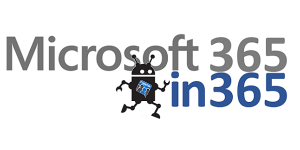My SharePoint and Office 365 Predictions for 2018
 In this month’s CollabTalk tweetjam on “Community Predictions for SharePoint and Office 365 in 2018“, I asked the people to weigh in on their picks for biggest stories of 2017, as well as where they thought things would go in 2018. Clearly, Microsoft Teams was the dominant Office 365 story for 2017, with a split between Communication and Hub Sites, and some of the new Admin Center capabilities for SharePoint. You can read the tweet-by-tweet summary of the tweetjam over on Storify (at least for the next 6 months, until they kill the platform, at which point I’ll move all of my stories over to my blog).
In this month’s CollabTalk tweetjam on “Community Predictions for SharePoint and Office 365 in 2018“, I asked the people to weigh in on their picks for biggest stories of 2017, as well as where they thought things would go in 2018. Clearly, Microsoft Teams was the dominant Office 365 story for 2017, with a split between Communication and Hub Sites, and some of the new Admin Center capabilities for SharePoint. You can read the tweet-by-tweet summary of the tweetjam over on Storify (at least for the next 6 months, until they kill the platform, at which point I’ll move all of my stories over to my blog).
You can read through some of my comments, but I largely agree with the consensus — Microsoft Teams sucked up most of the air within the Office 365 world — but will it continue to dominate in 2018? I’m not so sure. With the SharePoint Conference North America coming to Las Vegas in May (if you’ve not heard, this will be the first dedicated SharePoint conference since Microsoft Ignite was formed and the individual conferences were shut down, and while not a “Microsoft hosted event” per se, the company is throwing a lot of muscle and funding into it), and as a result, I expect SharePoint to make a move on biggest newsmaker.
Please take a look at the community feedback, and be sure to comment below on any items you feel are missing. Having said that, here are my own predictions for 2018:
- Modern sites will overtake classic, finally. Maybe they already have, officially, but people will stop whining about the disparity and just rip off the bandaids.
- There will be rapid expansion of bots and connectors in Teams and beyond, with vendors fully embracing the potential of this kind of automation, and customers embracing the new solutions to streamline how they collaborate and communicate.
- Hybrid SharePoint will maintain a healthy share of the market, despite all of the new capabilities in the pure cloud — because it’ll still be cost-effective to leave older infrastructure in place for now (at least until the next on-prem version).
- Microsoft will expand Office 365, Dynamics 365, and LinkedIn integrations, and more formally go after the major MarTech (that’s marketing technology, people) players by offerings more small to medium business solutions, like Microsoft Connections, that are native, or fully integrated with, the Microsoft platform. This will ruffle many partners who view this space as a partner opportunity, but it is the natural next-step for Microsoft.
- Microsoft Teams will displace SharePoint almost entirely within small businesses as a user experience — however, SharePoint will be increasingly leveraged through Teams in new and interesting ways as the platform continues to evolve and innovate.
- Telephony features will be added to Teams much more quickly than many anticipate, causing Skype for Business to die off even sooner. People ask what all the huff was about.
- Email news digests and email notifications will radically change how people consume information via SharePoint — and in some ways, drive the more casual users away from SharePoint as a UX and look at it more as infrastructure (you know….as an Intranet).
- Microsoft Graph will be further expanded, with huge improvements to the API, allowing for more rapid expansion of partner solutions that can leverage O365, Dynamics, LinkedIn, and their own systems and environments.
- Guest access in Teams will *finally* be solved, getting much closer to the ease-of-use of the pure-play cloud solutions that only require a simple email invite. This is all part of the larger vision for simplifying and unifying sharing and collaboration.
- SPFx extensions/customizations will provide further improvements for on-prem and hybrid, further extending existing on-prem investments.
In addition to my specific predictions, I also through it would be fun to track what I am calling the Office 365 “Power List” for 2018, listing out what I view to be the 10 biggest areas of focus in the SharePoint and Office 365 realm, and sorting them in order of where I see the biggest impact for 2018:
- Microsoft Teams
- PowerApps and Flow
- Dynamics 365
- SharePoint
- OneDrive
- Office 365 small business apps / solutions
- Office 365 Security & Compliance experience
- Office 365 Admin experience
- Yammer
- Outlook
Do you disagree with my Power List? Tell me where you agree or disagree! Ok, I’m heading upstairs to enjoy the rest of New Year’s Even with my family. See you in 2018!






Id put Power bi / sway in front of many other power users tools